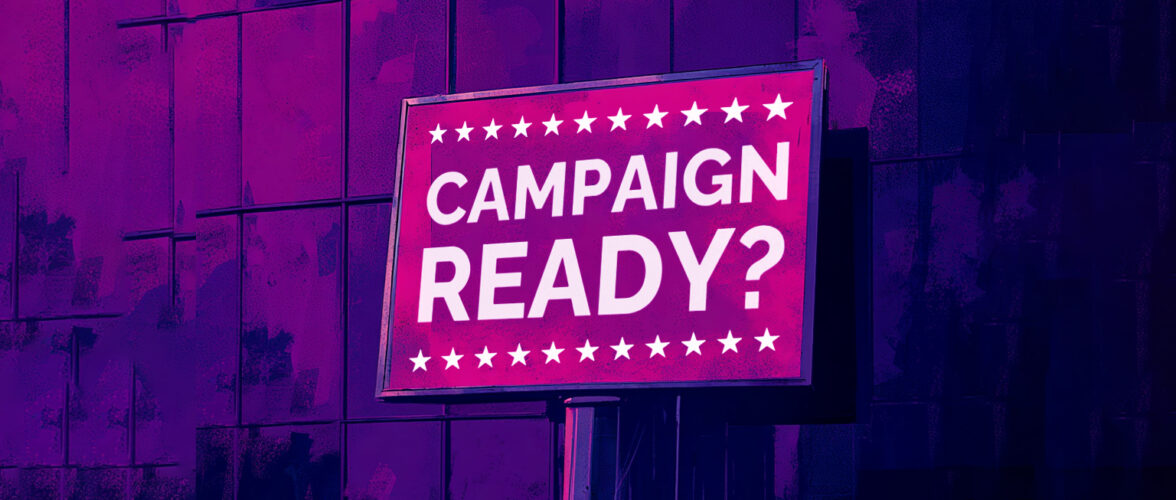Uncategorized

Posted on
October 9, 2025
7 Min. Read
Author
John Gatti
Reclaiming Trust When Under Fire
By John Gatti
Straight To The Point
- Today’s brands live under constant, unrelenting scrutiny — every decision is visible and judged in real time. Chasing trust is increasingly futile when it isn’t reinforced by visible steps that connect a brand to the future.
- Managing messages isn’t enough — leaders must close the gap between perception and reality across the whole business, and be open to changing reality.
- Build alignment, create a story worth hearing, and make every part of the organization part of the solution.
What We See

The way brands are judged has fundamentally shifted. Trust isn’t dead. But it’s dying. Yes, it still matters, but in today’s environment it isn’t enough. Trust is a conclusion stakeholders reach based on what you’ve already done. And in an era where Gallup and others show trust in institutions at historic lows, past performance alone won’t carry you forward. Your stakeholders want to know: are your best days ahead of you? Are you connected to the future? They are more likely to engage and support you if you are part of how they define a better tomorrow.
In my recent conversation with Neil Golden—Panera Brands board member and former McDonald’s USA CMO—we dug into what this means for companies under fire. Over his 30+ years guiding global brands through high-stakes moments, Neil has learned that these challenges aren’t rare events. They’re constant stress tests.
Take McDonald’s for example. Years ago, a single ingredient controversy might have been a temporary storm. Today, questions about food sourcing, product decisions, and corporate responsibility are permanent weather systems.
Neil put it plainly:
“You don’t win back trust with a press release. You earn it with actions people can see — and feel.”
That means companies that step up authentically in tough moments can come out stronger. Those that hide, delay, or spin? They don’t just lose trust — they hand the narrative to their critics and provide evidence that, just maybe, their best days aren’t in front of them.
What It Means

Here are the major shifts to reckon with:
Scrutiny never ends
When McDonald’s changed menus, reconfigured the Happy Meal, or rethought employment practices, those moves weren’t isolated—every step was watched, debated, and dissected. You don’t just survive one test—you’re living in a test environment.
Narratives are forever open
You can’t draft a “corrected” version later. Once your narrative is framed—by critics, news, customers—it holds a bias. The best defense is to get in early, with sincerity and clarity, not smarter spin.
Every function is a credibility channel
Marketing, HR, operations, supply chain—they all either bolster or erode your standing. As Neil stressed, reputation is not just a communications problem; it’s a business problem because the most important outcomes are measured in business performance.
Expect tension — and show the trade-offs
You’ll get pushed to pick a side. Be prepared to communicate not only wins but also the challenges, trade-offs, and constraints. Show the “messy middle” rather than pretending there wasn’t one.
What this means is simple: your lessons can’t live only in comms. They must operate in your thinking, your decisions, and your structures. That’s how you close the gap between what you stand for and what you’re known for.
What To Do

I’ve distilled five lessons for leaders determined not just to safeguard reputation, but to earn trust and prove that their organization’s best days are ahead through their choices and conduct.
- Aligning What You’re Known For with What You Stand For: If your brand’s purpose, intentions, and actions don’t align, people will decide for you—and not in your favor. Neil shared how moments of misalignment at McDonald’s, from marketing campaigns to public commitments, quickly turned into flashpoints. Leaders must make their values unmistakably clear, back them up with consistent behavior, and change when necessary.
- Telling Your Story Better or Having a Better Story to Tell: When a message isn’t breaking through, the first reaction is often to double down: repeat it, amplify it, shout it from every channel. But that’s just yelling louder. Neil and I discussed how the real challenge isn’t the delivery — it’s the narrative. McDonald’s had real progress to share, from healthier menu choices to better employment practices, but those actions weren’t woven into a story that felt relevant to people’s lives. Messaging alone wasn’t enough. It had to be in service of a narrative that framed the actions and signaled the company’s best days were ahead.
- Creating Buy-In Across the Whole Organization: Trust isn’t a marketing problem — it’s a full enterprise challenge. Neil emphasized that reputation lives or dies through daily decisions across the entire organization, not just in the marketing or comms department. Every function, every leader, every employee has a role to play in earning and protecting trust.
- Public Affairs is Marketing, Marketing is Public Affairs: There’s no longer a line between these two worlds. The same audiences you’re trying to reach as customers are also influencing public perception, regulatory decisions, and media narratives. And those stakeholders, in turn, are more interested in how you show up in the world than what you tell them. Consistency is mandatory. Inconsistency is mercilessly, immediately punished.
- Bait Needs to Taste Good to the Fish, Not the Fisherman: Good instincts are important, but they’re no substitute for research. Neil stressed that understanding what stakeholders really value is the only way to act effectively. You can’t just rely on what you think matters—you must listen and adapt based on what they care about, and what they need to hear and see.
Watch the Full Conversation: Reclaiming Trust When Your Products — and Intentions — Are Under Fire
A candid discussion with Neil Golden and Purple Partner John Gatti. [Watch the full video now →]

Posted on
September 19, 2025
60 Min. Read
Author
Purple Strategies
Reclaiming Trust When Your Products – and Intentions – are Under Fire
A Purple Strategies Conversation with Neil Golden
In this exclusive conversation, Neil Golden, current Panera Brands board member and former McDonald’s USA CMO, joins Purple Partner John Gatti to share hard-earned lessons from three decades leading iconic consumer brands.
From ingredient concerns to employment practices to public scrutiny, Neil reflects on how leaders can anticipate challenges, build resilient narratives, and protect reputation while driving business performance.
Whether you’re a communicator, marketer, or external affairs leader, this discussion offers practical insights into leading brands through today’s complex, high-stakes environment.

Posted on
September 3, 2025
3 Min. Read
Author
Purple Strategies
Brad Dayspring Joins Purple Strategies as Executive Director
From the West Wing to the C-suite, Dayspring has shaped strategy at the highest levels of politics, media, and business.
Purple Strategies announced today that Brad Dayspring has joined the firm as Executive Director, bringing more than two decades of experience at the intersection of politics, policy, media, and strategic communications.
Dayspring stands out as one of the few Washington strategists whose career spans the White House, Congressional Leadership, national campaigns, and the corporate media C-suite. He joins Purple after nearly a decade at POLITICO, where he served on the executive team as Executive Vice President of Global Communications and Brand. During his time at POLITICO, Dayspring advised multiple CEOs, editors-in-chief, and ownership groups, helping drive growth, profitability, and brand impact. He also served as trusted communications counsel to hundreds of publishing professionals and more than 500 journalists, spanning Washington, New York, California, London, Brussels, Paris, and Berlin.
“Brad is a rare talent whose experience, instincts, and drive align perfectly with Purple’s mission to help clients navigate change and unlock opportunity,” said Steve McMahon, co-founder and CEO of Purple Strategies. “He’s built a career in high-stakes environments — in government and the private sector — and knows how to turn complexity into clarity for leaders and brands facing critical moments. When the going gets tough, there’s no one better in the trenches than Brad Dayspring.”
Throughout his career, Dayspring has been a trusted advisor to CEOs, C-suite executives, elected officials, candidates, and industry leaders, guiding strategy in moments of crisis, legislative and regulatory pressure, and market transition. He’s known for his leadership, relentless work ethic, and unwavering loyalty — traits that have made him a sought-after partner in shaping communications strategy, policy advocacy, brand positioning, and stakeholder engagement.
At Purple, Dayspring will counsel clients on reputation management, issue advocacy, crisis, corporate positioning, and enterprise-level strategic communications. His deep understanding of political dynamics and media landscapes will further enhance Purple’s reputation as a leader in corporate reputation, public affairs, and issue advocacy.
“What drew me to Purple is its campaign-style mindset: hyper focused, strategic, and built for high-stakes moments and high-impact activation. In times like these, leaders don’t just need support — they need a steady hand, a sharp strategic mind, and a team that plays to where the puck is going, not where it’s been — and that’s where Purple stands out. I’m thrilled to join a firm with bold ambitions, an offense-minded approach, and a team I genuinely admire,” Dayspring said.
Dayspring began his career in the White House press office under President George W. Bush and later served as Deputy Chief of Staff and Communications Director to House Majority Leader Eric Cantor, as well as Communications Director at the National Republican Senatorial Committee. At POLITICO, he played a central role in transforming the brand into a global media leader, guiding the organization through acquisition, leadership transitions, and market expansion.
Brad is a native of Pompton Lakes, New Jersey, and holds a B.A. from Villanova University where he was an NCAA ice hockey player.

Posted on
August 29, 2025
1 Min. Read
Author
Purple Strategies
Celebrating Growth and Leadership at Purple
This season, we’re proud to celebrate the many promotions across our firm that reflect the growth and impact of our people at every level. Among them, four colleagues have stepped into new senior leadership roles.
- Tara Andersen – Executive Director
- Alec Jacobs – Managing Director
- Caroline Sage – Managing Director
- Jason Bargnes – Managing Director
Together, these client counselors and leaders bring decades of deep Purple experience plus prior backgrounds in policy, politics and management consulting to their work advising some of the world’s most important companies and industries. Each has made a lasting impact on our team and our clients — bringing bold thinking, deep collaboration, and an unwavering commitment to delivering results that matter. We are proud to recognize Tara, Alec, Caroline and Jason – along with all of our recently promoted Purple teammates – on their growth and continued leadership at Purple.

Posted on
August 28, 2025
5 Min. Read
Author
Purple Strategies
Has the narrative lost the story?
By Kevin Zier
Kevin Zier is an executive creative director at Purple with over 20 years of experience in brand and corporate reputation storytelling. His portfolio of work for Fortune 500 companies—in industries as wide ranging as healthcare, education, CPG, biotech, entertainment, energy, transportation, and manufacturing—has moved opinion, helped shape policy, and won creative awards. He also writes a lot of narratives.
Straight To The Point
- People don’t remember messages, they remember stories.
- The narrative was once how a company told its story, but most are just a messaging architecture written in paragraph form.
- When a narrative tries to say everything, it actually says nothing – too flat to guide decisions, too generic to get used, and more likely to end up on a shelf than in any hearts and minds.
- Return to real storytelling by building your narrative with ingredients people will care about – conflict, characters, transformation, and even redemption.
What We See

“Narrative” has become a universal catch-all in the consulting lexicon. We all agree it’s important. Every company has one. Some have several—one for the brand, another for the product, another for the CEO, another for the crisis. What could be different chapters or plotlines within one clear, compelling story has been replaced with headlines and bullet points. Emotion and tension have been sacrificed to make room for all the messaging that tested well.
What makes matters worse, the same messages always tend to test well. It’s why the world ends up with so many narratives that sound the same. How many companies promise to be “patient-centric” or “innovative” or “people over profit”? Ever heard a legacy company begin their narrative like this: “For over 126 years…”? Everyone might say they want to hear these buzzwords. But no one will remember them.
There are lots of reasons a narrative loses the story. Marketing wants their priorities in, government affairs want theirs, the C-suite wants coverage, legal wants protection, and everyone wants it to work with the AOR’s brand new ad campaign. With all these competing demands, the focus shifts to blending. This is not how you write a story. It’s how you make soup. While you ladle your grey mush into your audience’s bowls, your critics and competitors will be out there telling a much tastier story no one can ignore. That’s their only box to check.
What It Means

Great stories all have one thing in common: tension. Characters face a conflict. They make choices. They transform, and they succeed. Or they don’t, and they fail. Yes, avoiding tension in your narrative is a lot easier — the focus groups will definitely hate it. So, many teams stick to the sunny side of the street, talking in platitudes and sanding off the edges until nothing is left to feel about your company. And when there’s nothing to feel, a story doesn’t work. It doesn’t inspire, energize people internally, or serve its main purpose: to change hearts and minds and move opinion.
To do that, you must start with an idea, not a list. Proof should serve that idea, not the other way around. Effective narratives find the intersection of what your audience values and what you uniquely provide. When you find that, you’ll have an umbrella to guide smaller stories for products, issues, or moments. Make it memorable, human, and portable, too — and your leaders can carry it with them in shorthand, even (or especially) when crisis strikes. You’ll know you’ve done your job well when reporters, policymakers, and partners start using your language unprompted.
What To Do

At its core, a narrative is not a management exercise — it’s a story. And good ones have rules that endure, whether it’s on a Broadway stage or in a boardroom. David Mamet, the famous playwright, reminds us that drama only works when it puts real characters in motion, facing real tension, and undergoing transformation. A corporate narrative must do the same.
- Characters: In your narrative, characters are real people. You maybe can’t control who the antagonists are, but your protagonists need to be people your audience can relate to — leaders, employees, customers, even skeptics — not just abstract values and slogans.
- Setting: Where is the story happening and what are the details? This is the home for your data and messages. The trick is discerning which ones serve the plot, and which ones get in the way.
- Tension: All drama begins with conflict. A strong narrative doesn’t avoid the problem or chase consensus. It names the stakes, the obstacles, and the costs of failure. Without conflict, there’s no reason to care. No one to pull for or against.
- Transformation: A story that matters shows change — from risk to resilience, from problem to solution, from uncertainty to clarity. Transformation is what turns a list of messages into a journey people can believe in and rally around.
Does your narrative move your most important audiences the same way a good play or film does?
If not, maybe you should stop asking only what tested well. And instead, ask: Where is the tension? Who are the characters that matter? What is unique about us? What did we learn and how have we changed along the way? That is a story. One that will stir emotions, sharpen perspectives, and change the way people see the world.
People won’t remember the exact number of jobs you’ve created, how many billions you’ve poured into innovation, or how much you care about the environment or local communities. But tell a good story about why you’re doing all those things, and they’ll never forget it.
If you want to talk to Purple about your corporate narrative, get in touch with us.

Posted on
August 13, 2025
4 Min. Read
Author
Purple Strategies
Caught in the Middle: What Immigration Policy Means for Business
By: Carrie Healey
Carrie Healey runs strategic communications campaigns at Purple Strategies and previously led immigration and policy communications at the U.S. Chamber of Commerce, following years of experience in Democratic politics.
STRAIGHT TO THE POINT
- Immigration is no longer just a policy issue — it’s a brand risk. With increased enforcement, polarized politics, and employee fear colliding on the retail floor, companies can’t afford to be silent.
- Employees are walking off the job. Customers are paying attention. And ICE is showing up with or without warning. If your organization isn’t prepared to communicate quickly, compassionately, and in compliance with the law, you’re already behind.
- Silence is not safety. Transparency is the strategy.
What We See

American businesses – especially retailers, who are on the front lines of this issue – are under more pressure than ever before. Despite many undocumented workers being ineligible for employment, a recent survey from Pew revealed that 90% of Americans acknowledge undocumented workers take jobs U.S. citizens often won’t. But according to a recent Purple Strategies survey of the informed public, 67% of Americans still believe retailers should only employ verified workers, and 58% believe companies are breaking the law when undocumented employees are integrated within their supply chain — even if they aren’t directly employed by the retailer.
Immigration is also one of the most polarizing issues in American politics — and for companies, it often feels like there’s no safe ground. Move too far left, and you risk being labeled as soft on crime. Move too far right, and you’re branded as heartless. The left demands compassion and care for immigrants; the right demands strict enforcement and removal. At first glance, there seems to be little reward for speaking up — but plenty of risk for stepping wrong.
The threat of ICE activity, even if rumored, can trigger real disruptions; retail employees fear ICE raids and reputational damage is amplified when ICE agents take action on business premises. In addition, there is an expectation that companies publicly explain their policies — 79% of informed Americans say it’s important for businesses to be transparent — and that the status quo isn’t sustainable. In this climate, staying quiet isn’t neutral, it’s a missed opportunity.
What It Means

American Companies need a new playbook. Immigration enforcement is accelerating, and reputational risks are spreading across entire supply chains. The tools businesses have relied on to stay compliant — like E-Verify — are outdated. A 2019 CATO report found that E-Verify failed to detect more than 5 in 6 undocumented workers, and they’ve mistakenly flagged nearly 750,000 legal ones.
The public expects both lawful action and human compassion — 48% of informed Americans say companies should commit to both. For businesses, that means affirming hiring compliance and showing support for foreign-born employees who may be targeted by enforcement or fear for their families. The right message does more than signal intent — it demonstrates how you’re actively following the law while also standing behind your people. That includes communicating your compliance policies clearly and consistently and offering reassurance to employees whose lives — or their loved ones’ — may be disrupted by immigration enforcement.
And it’s not just about your direct employees. The public and the press won’t stop to parse your vendor contracts or supply chain structure. If an undocumented subcontracted employee is arrested at a store or warehouse, the headline will name the brand, not the subcontractor. That means companies must extend their communications expectations, compliance policies, and crisis planning across their entire contractor network. In this environment, who’s wearing your logo matters more than who’s on your payroll.
What To Do

- Audit your supply chain: Start by understanding where your risk exists. Review your vendors’ hiring practices and assess where visibility or verification may be weak. The public won’t parse fine print.
- Communicate like you care — because you do: Employees should hear from leaders directly. And 40% of the public want regular emails from senior leadership during periods of immigration uncertainty. Town halls, video messages, and internal FAQs can also go a long way to reduce fear.
- Pair compassion with compliance: Use messages that affirm you follow the law and support your people. We follow the law and care about our workers is not contradictory—it’s a competitive advantage.
- Build a rapid response team: Legal, communications, HR, and business leads should scenario-plan for enforcement actions or raids anywhere in your supply chain. Know who drafts the first statement, who fields media, who supports employees on the ground. Don’t scramble. Be ready.
- Stay proactive, not reactive: Don’t wait for ICE or activists to force your hand. Have a policy statement ready and train managers on what to do during a raid. Brief your suppliers on these policies and procedures and share your commitments internally and externally before a crisis hits.
Reputation and responsibility go hand in hand. The public expects clarity, not perfection. They want to know that businesses are following the law, protecting their workers, and communicating honestly.
Businesses don’t need to take a side in the immigration debate. But they do need to speak up, act smart, and be ready. Because right now, doing nothing is the riskiest move of all.
Want to talk about how to build an immigration-ready communications plan? Let’s connect.

Posted on
August 4, 2025
5 Min. Read
Author
Nina DeLorenzo
When Corporate Affairs Thinks Like Campaigns
Nina DeLorenzo has led and built communications and corporate affairs organizations at global companies including AbbVie, Sanofi and Emergent. She has also served in the White House, U.S. Department of State, U.S. Senate and on political campaigns. What is her take on what it really means to be “campaign ready”? It’s not what most leaders think.
Straight To The Point
- Today’s landscape doesn’t reward the slow, the passive, or those who operate with a comms-only mentality of yesteryear. In an age of weaponized misinformation and instant backlash, any company can become a political target.
- If your organization can’t move in unison quickly, pivot smartly and speak credibly under pressure, you’re not ready. And in this environment, not being ready is risky and expensive.
- Start treating your corporate affairs function like a campaign: comms and government relations in lockstep, built to engage, equipped to respond and ready to lead. Integration is crucial, and that also means with commercial and business leaders. Because when the heat is on, a well-designed PowerPoint deck about your top product won’t win you any battles.
What We See

Campaign readiness starts with an essential question: does your corporate affairs organization understand the company’s business strategy—and is it built to advance it? In too many companies, the answer is no.
Leaders often replicate generic organizational structures or apply templates that don’t reflect the business context. That’s a mistake. Comms and government relations teams that don’t work closely together and don’t understand the business will always be reactive. And in today’s environment, that’s not just a vulnerability—it’s a liability.
Being campaign ready isn’t about a binder full of crisis plans or a quarterly offsite. It’s about knowing where your business is going and what the external environment needs to look like in order for it to succeed. Campaign-ready means comms and GR shaping the environment to your advantage when you can, and forcefully countering obstacles when they arise. A campaign-ready corporate affairs organization can think, move and act like a campaign: ahead of the curve, aggressive when it needs to be, quiet when it’s strategic to be so, but always ready and aligned with your business.
The outside world moves fast. It doesn’t care how big your company is or how beloved your brand was yesterday. It has zero regard for your C-suite’s comfort zone. You need a campaign-ready organization to navigate it.
What It Means

Too many comms or corporate affairs leaders walk into roles thinking their job is to communicate business priorities or lobby in DC. That’s the bare minimum. Your real job? Help drive the business strategy by shaping the external environment to protect and promote it—and pivot on a dime when necessary.
At the same time, companies that thrive have leadership that treats corporate affairs like it’s as much part of the business as marketing or sales: essential to growth. The ones that flounder see comms as the team that writes the press releases and GR as the ones who lobby. And guess who gets clobbered when the external environment turns hostile?
The readiness checklist isn’t complicated—but it is critical. You need:
- People: They’re smart. They’re scrappy. They’re strategic. Not just “pencil-pushers”—people who can flex, adapt and act under pressure.
- Assets: You need a clear, resonant story. Along with a brand and assets that reflect it. Channels that reach the right audiences—fast. A PAC that’s not dormant. And data that tells you what’s working (and what’s not).
- Mindset: You should be the one looking around the next corner, unafraid to tell the CEO what’s there—even if it’s ugly. And you need to have a bias for action when things get messy because they will. Freezing in place—or hiding under the desk—is not an option.
What To Do About It

- Take your seat at the table. If you’re not helping shape business decisions, you’re not campaign ready—you’re an afterthought. Understand the business. Embed your team with their teams. Use that knowledge to drive strategy instead of just communicating the latest business updates.
- Insights are your foundation. Don’t build your strategy on instinct alone. Know how your company is perceived, internally and externally, where your story is strong and where it needs work. Understand where your competitors or those who might challenge you politically have an advantage. Have assets ready that reflect your brand and your business, and ensure you have the ability to generate insights quickly. Don’t be paranoid, but do be prepared.
- Act with the speed of a campaign, not of a legal department. Companies get paralyzed by perfection—and lawyers. Campaigns know perfection means losing the news cycle. Speed matters. Develop solid relationships with your CEO, Chief Counsel and others who can affect the speed of your response. Because the ability to say something smart and fast can often beat saying the “perfect” thing too late.
- Hire a team that’s ready to rumble. You will be challenged, whether it’s by activists, politicians, competitors or an angry ex-employee on social media (maybe all of them at once!). The question is: do you know how your organization will react? Will you respond with confidence—or will you scramble? Here’s where having a corporate affairs team that has comms and government relations under one roof, integrated with the business, with the right people and the right attitude—will make or break your response.
Campaigns don’t win based on who made the best Power Point. They win by taking action, being resilient and staying sharp. The same is true for organizations. If your corporate affairs function isn’t ready to move, adapt and lead—you’re not campaign ready.
Need help building a campaign-ready external affairs operation? Let’s talk.

Posted on
July 30, 2025
4 Min. Read
Author
Purple Strategies
Purple Strategies Adds Advisory Board of Seasoned Cross-Sector Leaders, Expanding Expertise and Networks that Advance Client Success
Purple Strategies, a strategic advisory firm focused on reputation, issues and advocacy for many of the world’s most important companies and organizations, today announced the formation of its Advisory Board. This distinguished group of leaders brings meaningful experience across corporate strategy and operations, issues and risk, communications and marketing, government and policy, and law. With backgrounds spanning C-suites, boardrooms and campaign war rooms, these Board members bring powerful perspectives that have helped them lead through disruption and change.
The Advisory Board further deepens Purple’s trusted counsel at the highest levels of business, industry, and the debates of the day. These advisors give the firm an additional stream of insight, acumen and strategic connections to help clients seize advantage in a stakeholder landscape where influence is constantly shifting.
“Purple is often the first call a leader makes when their organization is at a critical crossroads, and our Advisory Board is one more resource that strengthens our ability to meet the moment our clients are in — navigating pressure from every direction,” said Kristen Morgante, Managing Partner of Purple Strategies. “These leaders bring hard-earned judgment from decades in the rooms where pivotal decisions are made. Tapping into their wisdom and experience helps us sharpen our counsel and focus on building and protecting value for our clients. We’re honored to have them as part of our Purple team.”
Founding Advisory Board Members include:
- Machalagh Carr, founder of Quell Strategies and former Chief of Staff to Speaker of the House Kevin McCarthy, combines decades of legislative and energy sector expertise with frontline experience steering disruptive-tech companies through fast-moving policy and reputation currents, helping organizations anticipate shifts and turn innovation-driven scrutiny into strategic advantage.
- Neil Golden, a seasoned marketing executive, currently serving as a board member for Panera Brands and as a senior lecturer at Northwestern’s Medill School. A former Chief Marketing Officer of McDonald’s USA, he brings deep consumer insight and firsthand experience demonstrating how integrated marketing, public affairs and government relations can drive growth. His track record guiding iconic brands through disruption adds practical depth to conversations around reputation, revenue and resilience.
- Nina DeLorenzo, corporate affairs advisor and former executive at Pfizer, Sanofi, AbbVie and more. She is known for reimagining corporate affairs functions that reflect how influence moves and shapes business outcomes to deliver results across healthcare, pharmaceuticals, and other regulated sectors. Prior to working in the private sector, she served in the administration of President George W. Bush in the White House and the U.S. Department of State, in the United States Senate, and on political campaigns.
- Jerry Krulewitch, former EVP and General Counsel of McDonald’s Corporation, has led global legal strategy and crisis response for one of the world’s largest brands. Prior to that, he was an Assistant U.S. Attorney in the Northern District of Illinois. He brings decades of insight on the connections between enterprise risk, governance and reputation.
- Donna Brazile, former Chair of the Democratic National Committee and of the DNC’s Voting Rights Institute, is a veteran political strategist, author and nationally recognized commentator known for her work advancing bipartisan dialogue during the Clinton Administration and beyond. She brings decades of campaign, policy and public engagement experience alongside academic appointments at Georgetown, Howard and Harvard. She joined Purple in an earlier senior advisory role in 2022.
- David Bickerton, former senior advisor at BP and recent visiting fellow at the University of Oxford, has spent two decades steering global brands through the borderless currents of reputation, turning worldwide scrutiny into opportunity with integrated positioning, sustainability, and stakeholder engagement strategies across energy, financial services, food and beverage, automotive, and technology sectors. He joined Purple in an earlier senior advisory role in 2022.
Advisory Board members will provide strategic counsel to the firm on client challenges, contribute to thought leadership that advances our field and our thinking, and help push our offering and unlock new opportunities for Purple to add value for our clients.
Building out the Advisory Board is one part of a broader transformation underway at Purple — renewing how we lead, expanding how we think, and preparing clients for a world where influence is being reshaped in real time. To learn more about our approach at Purple – visit our collection of perspectives and insights.

Posted on
July 17, 2025
3 Min. Read
Author
Purple Strategies
Six Months In: What Trump Has Taught Us (So Far)
By: Chris Durlak
Straight to the Point
- Trump 2.0 isn’t chaos anymore — it’s the new normal. The playbook has changed.
- Speed and precision beat size and consensus. Influence goes to those who act fast, speak directly, and build the right coalition — not the biggest one.
- You don’t need to wait, you need to plan. Start communicating, build your coalition, map your influence, reframe your ask, and stay visible. The chaos may be constant, but your action can be too.
What We See

The shock has worn off. The chaos hasn’t.
Six months into Trump’s second term, the drama has become the drumbeat. The early flurry of executive orders and bombastic soundbites has given way to something more difficult to manage: predictably unpredictable governance.
And yet… everyone’s asking the same thing: Can this pace really continue?
He’s gotten his “big, beautiful” bill through Congress. His on-again, off-again feud with Elon dominates headlines. His star still burns bright. But stars that burn hottest often collapse fastest — and with an election looming, gravity is already making an impact.
No one knows what the next disruption will be. But we know there will be one. That uncertainty — the “known unknowns” — isn’t a barrier. It’s a feature of today’s strategic environment. The best strategies build in that unpredictability and still move forward with clarity and intention.
What It Means

(1) Build New and Different Alliances
Coalitions still matter, but what matters more is how they’re built and deployed. Where traditional associations speak for entire industries, there are moments that call for a more focused front: a small group of aligned players — sometimes even across sectors — coming together quickly around one high-stakes issue. MAGA (and MAHA) aren’t monoliths — they’re coalitions of convenience, often filled with strange bedfellows. That’s a feature, not a bug. Think of your own coalition that way: built for purpose, not perfection. It’s the manageability and shared urgency that matter.
Speed isn’t a bonus. It’s the requirement.
In the Trump era, influence windows open and shut in hours. At Purple, we’ve developed and launched brand-new, multi-channel campaigns in just days — because that’s the tempo today’s environment demands.
(2) Reposition Issues Strategically
It’s tempting to make it all about Trump — but real leverage often lies just beneath him: in the Cabinet, in Congress, and in the local politics that still shape national decisions.
Yes, Trump is the headliner. But cabinet secretaries, congressional allies, MAGA media influencers, even key donors and district-level players all hold cards. The smart move is to play the entire board. “All politics is local” still works — especially when the populist outcry risks real economic pain back home.
This moment also demands reframing. Using the language of populism — or even MAGA itself — can flip the script. If you’re seen as standing in the way of Trump’s next “big win,” you’re dead. But if your ask can become that win? He’ll claim it and run with it.
Trump wants big, beautiful victories. He rarely sweats the fine print. That’s where your opportunity lives — in the details. If the fix you need feels like fuel for his momentum, it’s more likely to happen. Repositioning isn’t spin. It’s strategy.
(3) Manage the Volatility – Don’t Let It Manage You
The bad news? Trump jumps from issue to issue and then jumps back again. What’s hot today might vanish tomorrow, only to resurface with more heat the next week.
The good news? He’s spread thin. You’re not.
That’s your strategic edge. You don’t need to chase or fear his attention — you get to shape your issue every day, with focus and consistency. Volatility doesn’t mean passivity. It means showing up smarter, faster, and without pause.
Too often, volatility becomes the rationale for doing nothing. Don’t wait. Use the downtime. Own the narrative. Get out there. Companies and associations who stay in-market — even when the president isn’t focused on their issue — are the ones best positioned when the spotlight swings back.
For many, just “getting out there” feels risky. But smart action doesn’t always mean public confrontation. Segment-specific, MAGA-coalition-oriented research and targeted influence mapping are steps that feel actionable — and safer — while still building readiness and momentum.
What To Do About It

Here are five moves you can make right now:
1. Stop waiting for permission. Start communicating now.
Create the content you’ve been holding whether it’s an explainer post, op-ed, or short video — and publish it. Not next quarter. Not next news cycle.
2. Convene your coalition — but keep it small and strategic.
Identify 3–5 organizations (they don’t need to be in your sector) who share your position on a specific issue. Convene the group. Align on language, audience, and a shared action.
3. Create a power map of influence.
Build a list of the 10–15 individuals who truly shape your issue (it probably doesn’t start with Trump). Think: agency heads, committee staffers, regional press, key donors, think tank voices, and trusted influencers in the MAGA universe.
4. Rewrite your ask through the lens of a Trump win.
Look at your top policy priority and reframe it in one sentence — not as your fix, but as his victory.
5. Launch your always-on engine — even in the quiet weeks.
Set a rhythm: one piece of content per week, one stakeholder meeting per month, one piece of new creative per quarter. Get up and stay up.
At Purple Strategies, we’ve helped companies do all of this and win. From building cross-sector coalitions in days, to reframing issues, to running always-on campaigns that break through the chaos — we’ve been in the middle of it, and we know how to deliver results.
Reach out — and let’s get to work. Contact Us.
For more content like this, subscribe to the Purple Point newsletter here.

Posted on
May 22, 2025
6 Min. Read
Author
Purple Strategies
What does corporate leadership look like in a divided nation?
Straight to the Point
- Nearly 70% of the informed public sees America’s political climate as deeply dysfunctional — and worsening.
- Corporate leaders can’t afford to retreat; they must shape their identity in the public arena or risk being defined by others.
- The most trusted companies will be those that act like the best people: clear, principled, and morally aligned with the public they serve.
What We See

We are living through an era of political fragmentation which most Americans expect will get worse before it gets better. Recent research from Purple Strategies’ Omnibus survey of the informed American public reveals that nearly 70% describe the current political climate as “divided” or worse, with a full third calling it “extremely polarized and dysfunctional.” Alarmingly, only a quarter view the current government as stable, and even among Republican and Trump voters, barely a third agree.
Looking ahead, few expect conditions to improve during this administration. Only about a quarter believe the nation will become more unified in the next few years. Among those who already view the system as broken, 85% don’t expect real improvement until after the 2028 election. In fact, a significant bloc (30%) of Republicans believe things will never improve.
This deeply pessimistic outlook isn’t confined to a political party or demographic; it’s shared broadly across the American public. In such an environment, waiting for things to “calm down” is no longer a viable strategy for corporate leaders.
What It Means

Alex Castellanos, Purple Strategies Co-Founder and Chairman, sees this moment as more than a political transition — it’s a structural realignment of how influence works in America. As he puts it, “We’re going from a world where the elites in smoke-filled back rooms had all the power, to one where networked individuals can topple them from the outside.”
The implication for businesses is clear: the traditional playbook of lobbying in Washington, building quiet Beltway relationships, and staying out of the public fray is now dangerously outdated. “If you think you can sit this out, enjoy your few remaining moments of peace. If you don’t define yourself, others will do it for you.”
In a networked world, trust and identity are earned in the open. Companies are no longer judged as faceless institutions, but as people. Today, the public evaluates companies using the same criteria it uses to judge a neighbor or a friend: Are you trustworthy, do you share my values, and will you stand by me when things get tough?
It’s not about corporations stepping in to govern. It’s about acting like the kind of company people would welcome into their lives. As Alex puts it: “Do I understand your motives? Are they aligned with mine? Are you the kind of company I’d have a beer with, or trust to make hard decisions when I’m not in the room?”
In a time of instability, a company’s clarity of purpose becomes its strongest asset. If you don’t communicate who you are, why your business exists, why you matter, and what lines you won’t cross, you’ll be perceived as a blank slate, or worse, as a target.
What To Do About It

Today, the certainty of your brand is more important than ever. That’s not just a strategic insight; it’s imperative for survival. As political instability deepens and the public’s trust in institutions frays, corporate leaders have a clear choice: define their enterprises with confidence or risk letting others do it for them. The good news? Companies that act intentionally — who know how they’re perceived, articulate their purpose, and work to build trust — can thrive in this moment. Here’s where to start:
1. Understand how you’re perceived — not just what you say
Before broadcasting your story, you need to understand how your stakeholders perceive you. Conduct research that reaches beyond the Beltway and traditional customer metrics. What values do people associate with you? Where are the gaps between how you want to be seen and how you actually are?
2. Define and defend your corporate identity
Develop a values-based narrative that reflects not only your financial mission but also your moral stance. This means articulating what you believe in ways that are human, relatable, and morally authentic. The public trusts companies the same way it trusts people — not because they’re perfect, but because they face the same moral choices we do and try to do what’s right.
3. Show up — before a crisis forces you to
Whether it’s a viral misinformation attack, a political flashpoint, or a regulatory ambush, you will be defined by how well you’ve prepared your audiences to understand who you are. If you’ve already built trust and clarity, you’ll have allies ready to support you. If not, you’ll be another piece of kindling in someone else’s fire.
4. Act with moral clarity, not political calculation
Resist the urge to go silent or speak in platitudes. Instead, speak plainly and show that your company is rooted in its purpose. The most effective companies demonstrate that they are good corporate human beings — trustworthy, dependable, and principled.
Purple Strategies helps some of the world’s leading companies navigate uncertainty and build lasting trust. If you’re rethinking how to lead in this polarized era, we’re here to help. Let’s talk.
For more content like this, subscribe to the Purple Point newsletter here.
 Reclaiming Trust When Your Products – and Intentions &...
Reclaiming Trust When Your Products – and Intentions &...  Brad Dayspring Joins Purple Strategies as Executive Director
Brad Dayspring Joins Purple Strategies as Executive Director  Celebrating Growth and Leadership at Purple
Celebrating Growth and Leadership at Purple  Reclaiming Trust When Under Fire
Reclaiming Trust When Under Fire